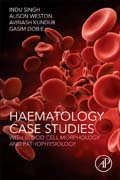
Hematology Case Studies with Blood Cell Morphology and Pathophysiology
Singh, Indu
Weston, Alison
Kundur, Avinash
Hematology Case Studies with Blood Cell Morphology and Pathophysiology begins with the reasons behind the importance of the blood film morphology in diagnosis of hematological disorders. Each case study starts with some of the possible symptoms followed by FBE or CBC results obtained from an automated hematology analyzer. These results include parameters such as hemoglobin (Hb), red cell count (RCC), packed cell volume (PCV), mean cell volume (MCV), mean cell haemoglobin (MCH), mean corpuscular haemoglobin concentration (MCHC), red cell distribution width (RDW), reticulocyte count, and white blood cell parameters (WBC), including white blood cell count and differential of white cells, and platelets count. Hematology Case Studies with Blood Cell Morphology and Pathophysiology compiles specific case studies with general and specific information about various hematological disorders with Full Blood Examination (FBE or CBC), blood film images, pathophysiology of the conditions and further confirmatory evaluation with their expected results for final diagnosis. This is what makes this unique but simple. This is the result of demand from industry for an all-in-one simple reference for teaching morphological skills to new trainees and upgrading skills of experiences workers starting rotation between various disciplines of a laboratory. It provides basic information about how to recognize and diagnose hematological conditions that are frequently observed in the laboratory. The populations of technicians and scientists who will benefit most from this book include those working in core laboratories including biochemistry or blood bank and are rotated around various disciplines as part of shift and weekend work. Moreover, it can be used as a reference book by technicians, scientists and hematologists alike because it includes information relevant to every level of expertise in diagnosing hematological disorders. Includes morphology of red cells, white cells and platelets. Images are actual blood slides under the microscope showing the most important diagnostic features seen in each condition, followed by the possible provisional diagnosis, differential diagnoses, further confirmatory tests that should be performed, and their expected results to make the final diagnosisProvides details that are considered difficult for beginners or non- hematologists, such as specific tests and techniques, and explains terms often used in order to make it as easy as possible to understandOrganization provides the serial order of all possible abnormalities seen in RBC, WBC and hemostatic (blood clotting and platelet) disorders, in no more than 3-5 pages back-to- back which allows the reader easy navigation and searching for various disorders and all detailed information with blood film images and diagnostic feature on it in a summarized but simple and effective wayEach case study finishes with the pathophysiology of the condition INDICE: 1. Introduction 2. Microcytic disorders 3. Normocytic disorders 4. Macrocytic disorders 5. Nonimmune haemolytic disorders (RBC metabolic abnormalities) 6. Nonimmune haemolytic disorders (RBC membrane abnormalities) 7. Immune haemolytic disorders 8. Acute leukaemias 9. Myeloproliferative/Myelodysplastic disorder 10. Chronic lymphoproliferative disorders 11. Lymphomas 12. Plasma cell disorders 13. Haemostatic disorders (microangiopathic haemolytic anaemia) 14. Haematological infections 15. References
- ISBN: 978-0-12-811911-2
- Editorial: Academic Press
- Encuadernacion: Rústica
- Páginas: 300
- Fecha Publicación: 01/08/2017
- Nº Volúmenes: 1
- Idioma: Inglés
